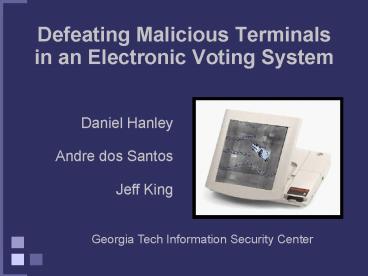Defeating Malicious Terminals in an Electronic Voting System PowerPoint PPT Presentation
1 / 29
Title: Defeating Malicious Terminals in an Electronic Voting System
1
Defeating Malicious Terminals in an Electronic
Voting System
Daniel Hanley Andre dos Santos Jeff King
Georgia Tech Information Security Center
2
Overview
- Motivation
- Related Work
- Protocol
- Examples
- Analysis
3
Motivation
- The Voting Problem
- Traditional Approach
- Electronic Voting
4
Motivation The Voting Problem
- Scenario Alice, a human, wishes to transmit
message c ? C to central tallier, Trent. - Security requirements
- Anonymity
- Accuracy
- etc.
5
Motivation Traditional Approach
- Paper-based systems
- Alice creates physical vote record and relays the
vote to Trent. - Disadvantages
- Inaccurate
- Expensive
- Advantages
- Simple, usable
- Secure (?)
6
Motivation Electronic Voting
- Current state of electronic voting systems
- Systems entrust untrustworthy voting terminals,
volunteers - Security policy dictates isolation and physical
controls - Advantages
- Relatively inexpensive
- Accurate
- Disadvantages
- Fails to use public infrastructure
- Vulnerable to automated attacks
- Vulnerable to undetectable attacks
7
Motivation Electronic Voting
- Current state of electronic voting systems
- Systems entrust untrustworthy voting terminals,
volunteers - Security policy dictates isolation and physical
controls - Advantages
- Relatively inexpensive
- Accurate
- Disadvantages
- Fails to use public infrastructure
- Vulnerable to automated attacks
- Vulnerable to undetectable attacks
8
Motivation Electronic Voting
- Solution Blind signature protocol with
trustworthy hardware - Direct communication with Trent infeasible!
- Trustworthy voting terminals costly!
- Personal tamper resistant device yes!
- Problem How can we establish a trusted path
between Alice and her voting device? - Direct I/O? Form factor prohibits this.
- Via voting terminal? No!
- CAPTCHA-Voting Protocol?
- Other schemes (Chaum, Prêt-à-Voter, KHAP)
- Voter performs verification and auditing steps.
9
Related Work
- Completely Automated Publicly Available Turing
Tests to tell Computers and Humans Apart
(CAPTCHAs) - One-time random substitution
10
Protocol Actors
- Alice a human voter
- Trent a central tallier, trusted to perform
- complex, anonymous operations on Alice's
behalf - Mallory an untrusted voting terminal
11
Protocol
- Public list of candidates C c1 , c2 , , cn
- Public, random set R r1 , r2 , , rm such
that m n - Random mapping of candidates to random elements
K C ? R such that - P( K(c) ri ) P( K(c) rj ) for all i, j
- K-1 R ? C
- CAPTCHA transformation function T(m) such that
Mallory cannot derive m from T(m), while Alice
may infer m from T(m) - Trent may encode K using T. This is denoted by
T(K).
12
Protocol
1. Trent generates and sends a CAPTCHA-encrypted
ballot.
1.1. K C ? R
13
Protocol
1. Trent generates and sends a CAPTCHA-encrypted
ballot.
1.1. K C ? R
1.2. T(K)
14
Protocol
1. Trent generates and sends a CAPTCHA-encrypted
ballot.
1.1. K C ? R
1.2. T(K)
1.3. T(K)
15
Protocol
2. Alice responds with the encrypted candidate.
1.1. K C ? R
1.2. T(K)
1.3. T(K)
2.1. T -1( T(K) ) K
16
Protocol
2. Alice responds with the encrypted candidate.
1.1. K C ? R
1.2. T(K)
1.3. T(K)
2.1. T -1( T(K) ) K
2.2. K(c) r
17
Protocol
2. Alice responds with the encrypted candidate.
1.1. K C ? R
1.2. T(K)
1.3. T(K)
2.1. T -1( T(K) ) K
2.2. K(c) r
2.3. r
18
Protocol
3. Trent decrypts Alice's preferred candidate.
1.1. K C ? R
1.2. T(K)
1.3. T(K)
2.1. T -1( T(K) ) K
2.2. K(c) r
2.3. r
3.1. K -1(r) c
19
Examples
- Text CAPTCHA
- 3D Animation CAPTCHA
- Audio CAPTCHA
20
Example Text CAPTCHA
- R consists of distinct regions in image.
- T renders mapping as image and contributes noise.
21
Example 3D Animation CAPTCHA
- R consists of equally sized, contiguous sets of
frames. - T renders candidate names in animation.
22
Example Audio CAPTCHA
- K is a similar, temporal mapping of candidates.
- Audio noise thwarts Mallory.
23
Analysis
- Fabricated votes
- Human adversaries
- Selective denial of service
24
Analysis Fabricated Votes
- Fabricated vote through guessed K
- Mallory attempts to vote for c' through selection
of arbitrary r''. - If R C, then P( K-1(r'') c' ) 1 / n.
- If R gt C, then P( K-1(r'') c' ) 1 / m.
- Probability that K-1(r'') is undefined (m n) /
m - Invalid vote ? detected attack!
- Fabricated vote through cracked T
- Mallory increases probability that P( K-1(r'')
c' ). - Solution Find a better CAPTCHA?
25
Analysis Human Adversary
- Transmission of T(K) to a human collaborator
- Time-dependent protocol
- Increased likelihood of detection
- Architectural solutions
26
Analysis Selective DoS
- Selective DoS Mallory discards Alice's vote if
it is likely that c ? c'. - Mallory must learn Alice's preference.
- Alice and Mallory's location
- Alice's previous votes
- Solution Single ballot
- Fabricated ballot
- Detection of selective denial of service
- Educated guessing
27
Conclusion
- Human interaction required no efficient
automated attacks - Easy detection of large-scale attacks
- Comparison to traditional voting systems
- Future work
- Usability data
- Broader applications, using this protocol
(possibly combined with KHAP) to form a trusted
path
28
Questions?
29
Questions?

